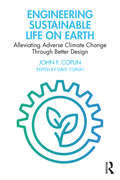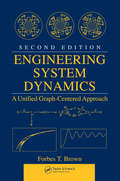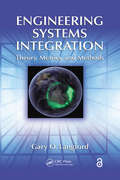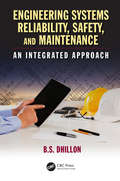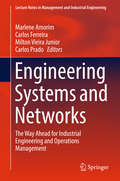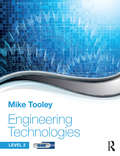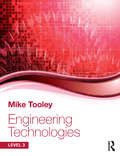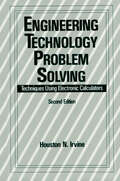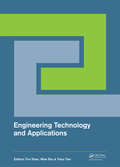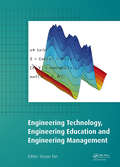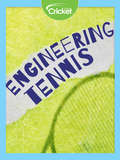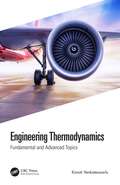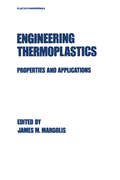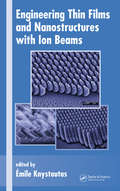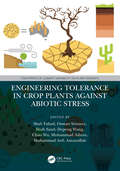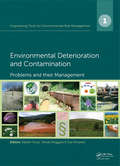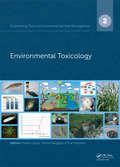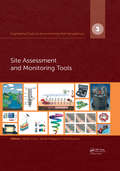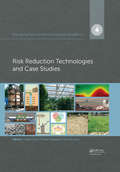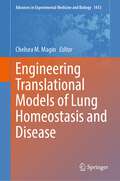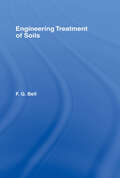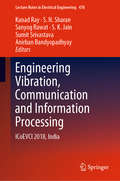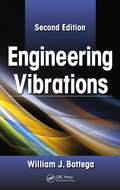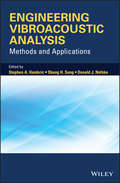- Table View
- List View
Engineering Sustainable Life on Earth: Alleviating Adverse Climate Change Through Better Design
by John F. CoplinClimate scientists have clarified the main causes of climate change, and the tight timescale within which humans must change behaviour, and implement effective solutions, wherever they are needed across the world. This book uncovers many of the powerful actions and uses them effectively to achieve sustainable human life, of improved quality, in a way that is affordable out of earned income for all humans, wherever they live. The ultimate solution to climate change lies not just in doing and consuming less but does instead entirely revolve around our ability to "out innovate" the problem. John F. Coplin, CBE, FREng, FCGI, has had a long and distinguished career in engineering and has operated and advised at all levels from heads of state, company chairs, engineering directors, government advisory boards, and on the shop floor. He is perfectly placed to take a wide-ranging approach, applying modern design and innovative engineering at a systemic level in order to provide novel approaches that will have far-reaching impact on reversing humankind’s impact on this planet. His projections and solutions are based on facts, reasonable calculations, and science learnt from nature. Unafraid to challenge current thinking, John looks at solutions across multiple sectors, including aviation, cars and domestic local transport, clean and renewable energy, food and agriculture, and housing and communities, and describes the particular potential of hydrogen as fuel. The book is written in a language for all. It is small enough to be used is a practical guide to where some of the most useful improvements are to be found and as a way to start important conversations.
Engineering System Dynamics: A Unified Graph-Centered Approach, Second Edition
by Forbes T. BrownFor today's students, learning to model the dynamics of complex systems is increasingly important across nearly all engineering disciplines. First published in 2001, Forbes T. Brown's Engineering System Dynamics: A Unified Graph-Centered Approach introduced students to a unique and highly successful approach to modeling system dynamics using bond g
Engineering Systems Integration: Theory, Metrics, and Methods
by Gary O. LangfordThe first book to address the underlying premises of systems integration and how to exposit them into a practical and productive manner, this book prepares systems managers and systems engineers to consider their decisions in light of systems integration metrics. The book addresses two questions: Is there a way to express the interplay of human actions and the result of system interactions of a product with its environment, and are there methods that combine to improve the integration of systems? The systems integration theory and integration frameworks proposed in the book tie General Systems Theory with practice.
Engineering Systems Reliability, Safety, and Maintenance: An Integrated Approach
by B. S. DhillonToday, engineering systems are an important element of the world economy and each year billions of dollars are spent to develop, manufacture, operate, and maintain various types of engineering systems around the globe. Many of these systems are highly sophisticated and contain millions of parts. For example, a Boeing jumbo 747 is made up of approximately 4.5 million parts including fasteners. Needless to say, reliability, safety, and maintenance of systems such as this have become more important than ever before. Global competition and other factors are forcing manufacturers to produce highly reliable, safe, and maintainable engineering products. Therefore, there is a definite need for the reliability, safety, and maintenance professionals to work closely during design and other phases. <P><P>Engineering Systems Reliability, Safety, and Maintenance: An Integrated Approach eliminates the need to consult many different and diverse sources in the hunt for the information required to design better engineering systems.
Engineering Systems and Networks
by Marlene Amorim Carlos Ferreira Milton Vieira Junior Carlos PradoThis book gathers a selection of the best papers presented at the joint international conference ICIEOM-CIO-IIE 2015, offering recent research on industrial engineering, management and operations from an international and interdisciplinary perspective. It includes contributions from different fields, such as operations research, modeling and simulation, production and service management and logistics, information systems and quality, and as such is of interest to both researchers and practitioners. Reflecting the interconnected nature of today's production systems, characterized by intense flows of goods, information and individuals between companies and nations, it is a valuable resource for anyone wanting an in-depth understanding of the field to guide managerial practice in order to take full advantage of existing opportunities.
Engineering Technologies: Level 2
by Mike TooleyCovers the three mandatory units of the EAL Level 2 Diploma in Engineering and Technology Each compulsory unit is covered in detail with activities, practice exercises and examples where relevant Review questions are provided at the end of each chapter and a sample multiple-choice examination paper is included at the end of the book Contains expert advice that has been written in collaboration with EAL to ensure that it covers what learners need to know Answers to selected questions in the book, together with other supporting resources, can be found at the book’s companion website. Numerical answers are provided in the book itself. Written specifically for the EAL Level 2 Diploma in Engineering and Technology, this book covers the three mandatory units on this course: Engineering Environment Awareness, Engineering Techniques, and Engineering Principles. Within each unit, the Learning Outcomes are covered in detail and the book includes activities and test your knowledge sections to check your understanding. At the end of each chapter is a checklist to make sure you have achieved each objective before you move onto the next section. At www.key2engtech.com, you can download answers to selected questions found within the book, as well as reference material and resources to support several other EAL units. This book is a must have for all learners studying for their EAL Level 2 Diploma award in Engineering and Technology and contains all of the essential knowledge you need to complete this course.
Engineering Technologies: Level 3
by Mike TooleyEngineering Technologies covers the mandatory units for the EAL Level 3 Diploma in Engineering and Technology: Each compulsory unit is covered in detail with activities, case studies and self-test questions where relevant. Review questions are provided at the end of each chapter and a sample multiple-choice examination is included at the end of the book. The book has been written to ensure that it covers what learners need to know. Answers to selected questions in the book, together with a wealth of supporting resources, can be found on the book’s companion website. Numerical answers are provided in the book itself. Written specifically for the EAL Level 3 Diploma in Engineering and Technology, this book covers the two mandatory units: Engineering and Environmental Health and Safety, and Engineering Organizational Efficiency and Improvement. Within each unit, the learning outcomes are covered in detail and the book includes activities and ‘Test your knowledge’ sections to check your understanding. At the end of each chapter is a checklist to make sure you have achieved each objective before you move on to the next section. At www.key2engtech.com, you can download answers to selected questions found within the book, as well as reference material and resources. This book is a ‘must-have’ for all learners studying for their EAL Level 3 Diploma award in Engineering and Technology.
Engineering Technology Problem Solving: Techniques Using Electronic Calculators, Second Edition
by Houston N. IrvineThis book covers the main special functions that are available on the two most popular calculators, the Texas Instruments TI-55 and the Hewlett-Packard HP-33E. It is designed for use by beginning engineering and technical students and as a handbook for calculator applications.
Engineering Technology and Applications: Proceedings of the 2014 International Conference on Engineering Technology and Applications (ICETA 2014), Tsingtao, China, 29-30 April 2014
by Fun Shao Wise Shu Tracy TianEngineering Technology and Applications contains the contributions presented at the 2014 International Conference on Engineering Technology and Applications (ICETA 2014, Tsingtao, China, 29-30 April 2014). The book is divided into three main topics: Civil and environmental engineering Electrical and computer engineering Mechanical engineeringCon
Engineering Technology, Engineering Education and Engineering Management: Proceedings of the 2014 International Conference on Engineering Technology, Engineering Education and Engineering Management (ETEEEM 2014), Hong Kong, 15-16 November 2014
by Deyao TanThis volume contains papers presented at the International Conference on Engineering Technologies, Engineering Education and Engineering Management (ETEEEM 2014, Hong Kong, 15-16 November 2014). A wide variety of topics is included in the book: - Engineering Education - Education Engineering and Technology - Methods and Learning Mechanism
Engineering Tennis
by Cricket MediaSports engineering analyzes a player's moves and the equipment. One challenge was the "spaghetti racquet", which caused an uproar in the tennis world.
Engineering Thermodynamics: Fundamental and Advanced Topics
by Kavati VenkateswarluThis textbook comprehensively covers the fundamentals and advanced concepts of thermodynamics in a single volume. It provides a detailed discussion of advanced concepts that include energy efficiency, energy sustainability, energy security, organic Rankine cycle, combined cycle power plants, combined cycle power plant integrated with organic Rankine cycle and absorption refrigeration system, integrated coal gasification combined cycle power plants, energy conservation in domestic refrigerators, and next-generation low-global warming potential refrigerants. Pedagogical features include solved problems and unsolved exercises interspersed throughout the text for better understanding. This textbook is primarily written for senior undergraduate students in the fields of mechanical, automobile, chemical, civil, and aerospace engineering for courses on engineering thermodynamics/thermodynamics and for graduate students in thermal engineering and energy engineering for courses on advanced thermodynamics. It is accompanied by teaching resources, including a solutions manual for instructors. FEATURES Provides design and experimental problems for better understanding Comprehensively discusses power cycles and refrigeration cycles and their advancements Explores the design of energy-efficient buildings to reduce energy consumption Property tables, charts, and multiple-choice questions comprise appendices of the book and are available at https://www.routledge.com/9780367646288.
Engineering Thermoplastics: Properties and Applications
by James M. MargolisThis book provides solutions to many vital questions on the important property differences and advantages of individual engineering thermoplastics. It is useful for executives; managers; design, materials, and sales engineers; researchers; materials and product manufacturers; and compounders.
Engineering Thin Films and Nanostructures with Ion Beams (Optical Science and Engineering)
by Émile KnystautasWhile ion-beam techniques have been used to create thin films in the semiconductor industry for several decades, these methods have been too costly for other surface treatment applications. However, as manufacturing devices become increasingly smaller, the use of a directed-energy ion beam is finding novel industrial applications that require the custom tailoring of new materials and devices, including magnetic storage devices, photonics, opto-electronics, and molecular transport. Engineering Thin Films and Nanostructures with Ion Beams offers a thorough narrative of the recent advances that make this technology relevant to current and future applications.Featuring internationally recognized researchers, the book compiles their expertise in a multidimensional source that:Highlights the mechanisms and visual evidence of the effects of single-ion impacts on metallic surfacesConsiders how ion-beam techniques can help achieve higher disk-drive densities Introduces gas-cluster ion-beam technology and reviews its precedentsExplains how ion beams are used to aggregate metals and semiconductors into nanoclusters with nonlinear optical propertiesAddresses current challenges in building equipment needed to produce nanostructures in an industrial setting Examines the combination of ion-beam techniques, particularly with physical vapor deposition Delineates the fabrication of nanopillars, nanoflowers, and interconnected nanochannels in three dimensions by using atomic shadowing techniques Illustrates the production of nanopores of varying dimensions in polymer films, alloys, and superconductors using ion-beam irradiationShows how fingerprints can be made more reliable as forensic evidence by recoil-mixing them into the substrate using ion beamsFrom the basics of the ion-beam modification of materials to state-of-the-art applications, Engineering Th
Engineering Tolerance in Crop Plants Against Abiotic Stress (Footprints of Climate Variability on Plant Diversity)
by Shah FahadDespite significant progress in increasing agricultural production, meeting the changing dietary preferences and increasing food demands of future populations remains a significant challenge. Salinity, drought, water logging, high temperature and toxicity are abiotic stresses that affect the crop yield and production. Tolerance for stress is a important characteristic that plants need to have in order to survive. Identification of proper techniques at a proper time can make it easy for scientists to increase crop productivity and yield. In Engineering Tolerance in Crop Plants against Abiotic Stress we have discussed the possible stresses and their impact on crops and portrayed distinctive abiotic stress tolerance in response to different techniques that can improve the performance of crops. Features of the Book: Provide a state-of-the-art description of the physiological, biochemical, and molecular status of the understanding of abiotic stress in plants. Address factors that threaten future food production and provide potential solution to these factors. Designed to cater to the needs of the students engaged in the field of environmental sciences, soil sciences, agricultural microbiology, plant pathology, and agronomy. New strategies for better crop productivity and yield. Understanding new techniques pointed out in this book will open the possibility of genetic engineering in crop plants with the concomitant improved stress tolerance.
Engineering Tools for Environmental Risk Management: 1. Environmental Deterioration and Contamination - Problems and their Management (Engineering Tools for Environmental Risk Management)
by John R. Wilson Sarah SharplesThis is the first volume of the five-volume book seriesEngineering Tools for Environmental Risk Management dealing with the following topics: types and management of environmental deterioration, particularly pollution; environmental toxicology as a versatile tool in monitoring and risk management; risk assessment of chemical substances and c
Engineering Tools for Environmental Risk Management: 2. Environmental Toxicology (Engineering Tools for Environmental Risk Management)
by Katalin Gruiz Tamás Meggyes Éva FenyvesiChemical substances, physical agents and built structures exhibit various types of hazard due to their inherent toxic, mutagenic, carcinogenic, reprotoxic and sensitizing character or damaging to the immune and hormone system. The first steps in managing an environment contaminated by chemical substances are characterization of hazards and quantifi
Engineering Tools for Environmental Risk Management: 3. Site Assessment and Monitoring Tools (Engineering Tools for Environmental Risk Management #3)
by Katalin Gruiz Éva Fenyvesi TamásThis is the third volume of the five-volume book series “Engineering Tools for Environmental Risk Management”. The book series deals with the following topics: • Environmental deterioration and pollution, management of environmental problems• Environmental toxicology – a tool for managing chemical substances and contaminated environment• Assessment and monitoring tools, risk assessment• Risk reduction measures and technologies• Case studies for demonstration of the application of engineering tools The authors aim to describe interactions and options in risk management by providing a broad scientific overview of the environment, its human uses and the associated local, regional and global environmental problems; interpreting the holistic approach used in solving environmental protection issues; striking a balance between nature’s needs and engineering capabilities; understanding interactions between regulation, management and engineering; obtaining information about novel technologies and innovative engineering tools. This third volume provides an overview on the basic principles, concepts, practices and tools of environmental monitoring and contaminated site assessment. The volume focuses on those engineering tools that enable integrated site assessment and decision making and ensure an efficient control of the environment. Some topics supporting sustainable land use and efficient environmental management are listed below: • Efficient management and regulation of contaminated land and the environment;• Early warning and environmental monitoring;• Assessment of contaminated land: the best practices;• Environmental sampling;• Risk characterization and contaminated matrix assessment;• Integrated application of physical, chemical, biological, ecological and (eco) toxicological characterization methods;• Direct toxicity assessment (DTA) and decision making;• Online analyzers, electrodes and biosensors for assessment and monitoring of waters.;• In situ and real-time measurement tools for soil and contaminated sites;• Rapid on-site methods and contaminant and toxicity assessment kits;• Engineering tools from omics technologies, microsensors to heavy machinery;• Dynamic characterization of subsurface soil and groundwater using membrane interface probes, optical and X-ray fl uorescence and ELCAD wastewater characterization;• Geochemical modeling: methods and applications;• Environmental assessment using cyclodextrins. This book series focuses on the state of knowledge about the environment and its conscious and structured application in environmental engineering, management and decision making.
Engineering Tools for Environmental Risk Management: 4. Risk Reduction Technologies and Case Studies (Engineering Tools for Environmental Risk Management #4)
by Katalin Gruiz Tamás Meggyes Éva FenyvesiThe four volumes of the book series "Engineering Tools for Environmental Risk Management" deal with environmental management, assessment & monitoring tools, environmental toxicology and risk reduction technologies. This last volume focuses on engineering solutions usually needed for industrial contaminated sites, where nature’s self-remediation is inefficient or too slow. The success of remediation depends on the selection of an increasing number of conventional and innovative methods. This volume classifies the remedial technologies and describes the reactor approach to understand and manage in situ technologies similarly to reactor-based technologies. Technology types include physicochemical, biological or ecological solutions, where near-natural, sustainable remediation has priority. <P><P>A special chapter is devoted to natural attenuation, where natural changes can help achieve clean-up objectives. Natural attenuation and biological and ecological remediation establish a serial range of technologies from monitoring only to fully controlled interventions, using ‘ just’ the natural ecosystem or sophisticated artificial living systems. Passive artificial ecosystems and biodegradation-based remediation – in addition to natural attenuation – demonstrate the use of these ‘green’ technologies and how engineering intervention should be kept at a minimum to limit damage to the environment and create a harmonious ecosystem. <P><P>Remediation of sites contaminated with organic substances is analyzed in detail including biological and physicochemical methods. Comprehensive management of pollution by inorganic contaminants from the mining industry, leaching and bioleaching and acid mine drainage is studied in general and specifically in the case of an abandoned mine in Hungary where the innovative technology of combined chemical and phytostabilization has been applied. <P><P>The series of technologies is completed by electrochemical remediation and nanotechnologies. Monitoring, verification and sustainability analysis of remediation provide a comprehensive overview of the management aspect of environmental risk reduction by remediation. This book series focuses on the state of knowledge about the environment and its conscious and structured application in environmental engineering, management and decision making.
Engineering Translational Models of Lung Homeostasis and Disease (Advances in Experimental Medicine and Biology #1413)
by Chelsea M. MaginCutting-edge engineering approaches towards modelling lung homeostasis and disease have created dynamic new opportunities for interdisciplinary collaboration and unprecedented progress toward understanding and treating lung disease. This text connects established research in lung biology and physiology to innovative engineering strategies for pulmonary modelling. This unique approach aims to encourage and facilitate progress among a greater audience of basic and translational scientists, clinicians, and medical practitioners. Engineering Translational Models of Lung Homeostasis and Disease illustrates the advances in lung tissue characterization, revealing dynamic changes in the structure, mechanics, and composition of the extracellular matrix. This information paves the way for tissue-informed engineering models of pulmonary tissue, improved design of clinical materials, and advances against a variety of common pathologies. Current translational challenges are highlighted, as are engineering opportunities to overcome these barriers. This foundational text holds valuable lessons for researchers and clinicians throughout the fields of engineering, materials science, cell biology, pulmonary medicine, and clinical science.· Each section focuses on a specific region of the lung, presenting either the biological or clinical perspective along with complimentary engineering approaches · Covers the interface of engineering and lung biology · Highlights emerging new models to study lung disease and repair
Engineering Treatment of Soils
by Fred BellThis book reviews the techniques used to improve the engineering behaviour of soils, either in situ or when they are used as a construction material. It is a straightforward, well illustrated and readable account of the techniques and includes numerous up-to-date references.
Engineering Vibration, Communication and Information Processing: Icoevci 2018, India (Lecture Notes In Electrical Engineering #478)
by S. K. Jain Kanad Ray Sanyog Rawat Anirban Bandyopadhyay Sumit Srivastava S. N. SharanThis book discusses the revolution of cycles and rhythms that is expected to take place in different branches of science and engineering in the 21st century, with a focus on communication and information processing. It presents high-quality papers in vibration sciences, rhythms and oscillations, neurosciences, mathematical sciences, and communication. It includes major topics in engineering and structural mechanics, computer sciences, biophysics and biomathematics, as well as other related fields. Offering valuable insights, it also inspires researchers to work in these fields. The papers included in this book were presented at the 1st International Conference on Engineering Vibration, Communication and Information Processing (ICoEVCI-2018), India.
Engineering Vibrations
by William J. BottegaA thorough study of the oscillatory and transient motion of mechanical and structural systems, Engineering Vibrations, Second Edition presents vibrations from a unified point of view, and builds on the first edition with additional chapters and sections that contain more advanced, graduate-level topics. Using numerous examples and case studies, the author reviews basic principles, incorporates advanced abstract concepts from first principles, and weaves together physical interpretation and fundamental principles with applied problem solving. This revised version combines the physical and mathematical facets of vibration, and emphasizes the connecting ideas, concepts, and techniques.
Engineering Vibroacoustic Analysis
by Stephen A. Hambric Shung H. Sung Donald J. NefskeThe book describes analytical methods (based primarily on classical modal synthesis), the Finite Element Method (FEM), Boundary Element Method (BEM), Statistical Energy Analysis (SEA), Energy Finite Element Analysis (EFEA), Hybrid Methods (FEM-SEA and Transfer Path Analysis), and Wave-Based Methods. The book also includes procedures for designing noise and vibration control treatments, optimizing structures for reduced vibration and noise, and estimating the uncertainties in analysis results. Written by several well-known authors, each chapter includes theoretical formulations, along with practical applications to actual structural-acoustic systems. Readers will learn how to use vibroacoustic analysis methods in product design and development; how to perform transient, frequency (deterministic and random), and statistical vibroacoustic analyses; and how to choose appropriate structural and acoustic computational methods for their applications. The book can be used as a general reference for practicing engineers, or as a text for a technical short course or graduate course.
Engineering Vibroacoustic Analysis: Methods and Applications
by Stephen A. Hambric Shung H. Sung Donald J. NefskeThe book describes analytical methods (based primarily on classical modal synthesis), the Finite Element Method (FEM), Boundary Element Method (BEM), Statistical Energy Analysis (SEA), Energy Finite Element Analysis (EFEA), Hybrid Methods (FEM-SEA and Transfer Path Analysis), and Wave-Based Methods. The book also includes procedures for designing noise and vibration control treatments, optimizing structures for reduced vibration and noise, and estimating the uncertainties in analysis results. Written by several well-known authors, each chapter includes theoretical formulations, along with practical applications to actual structural-acoustic systems. Readers will learn how to use vibroacoustic analysis methods in product design and development; how to perform transient, frequency (deterministic and random), and statistical vibroacoustic analyses; and how to choose appropriate structural and acoustic computational methods for their applications. The book can be used as a general reference for practicing engineers, or as a text for a technical short course or graduate course.
